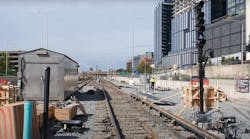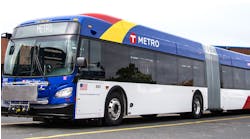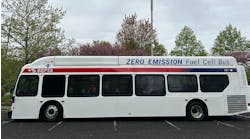Mar. 14—Aliyah Johnson is a regular Metro Bus rider, who lives in the Kensington-Bailey neighborhood.
She catches two buses every morning to work, picking up the first one on Bailey Avenue and then transferring to another.
It's not exactly a seamless ride, she said.
"(Sometimes) I might miss my next bus because traffic is so busy so I'm late to catch my next bus," she said recently while waiting at a Bailey Avenue bus stop.
Johnson is among approximately 2,600 commuters who use a Bailey Avenue Metro Bus every weekday, according to the Niagara Frontier Transportation Authority. It's one of the NFTA's busiest bus routes.
With a $102.7 million federal grant, the NFTA is planning to build a bus rapid transit line on a 7.5-mile stretch of Bailey from Main Street south to South Park Avenue. The new transit line will provide frequent, high-capacity bus services with dedicated bus lanes that can only be used by buses either all day or during certain times, typically peak traffic hours.
The NFTA has not finalized its bus rapid transit design plans, so exactly what changes will be made to Bailey Avenue are not known, but bus riders can expect a trip down Bailey to be faster, possibly by about 16 minutes. Some of the possibilities include a dedicated bus-only lane, fewer bus stops and a high-tech system that tells people waiting for buses when the next one will arrive.
The upgrades will help Bailey Avenue become friendlier for walkers and bikers while also improving traffic flow along the corridor, according to U.S. Senate Majority Leader Charles Schumer and Sen. Kirsten E. Gillibrand, both New York Democrats. They announced the funding on Monday, but The Buffalo News broke the news on Sunday.
The federal funding will support the design and construction of the rapid transit line and safety improvements along the 7.5-mile path, which are expected to cost about $102 million. Schumer said the bus rapid transit project and related improvements should make the route safer for commuters.
Johnson said the plan "sounds nice. It will be more helpful for people that catch the bus."
"I think it's a good idea because there have been plenty of accidents with cars and buses," said Danielle Linton, who has lived in the Kensington-Bailey neighborhood for about two years.
According to a 2021 NFTA study, there have been more than 2,500 collisions along Bailey in the past five years as buses currently compete for road space on a broad urban thoroughfare often jammed with other vehicle traffic.
From January 2014 to December 2019, a total of 2,561 collisions were recorded. The majority of crashes, 86%, involved a collision with a motor vehicle. Five percent involved a collision with a pedestrian, 2% involved a collision with a light support or utility pole, and 2% involved in a collision with a bicyclist.
What is bus rapid transit?
BRT is a high-capacity bus-based transit system.
The running time for the Bailey Avenue BRT route could be 16 minutes less than existing service, decreasing from an average of 40 minutes to 24 minutes during the morning peak and an average of 25 minutes in the afternoon peak, according to a study by NFTA.
The project would need a full redesign of Bailey Avenue, according to a Feb. 29 presentation to the NFTA board. But the final design details will be determined after the comprehensive study is complete, and that is expected to be done by 2026, said Helen Tederous, a spokeswoman for the NFTA.
"You may not necessarily have to do that (widen the road), and that's what the engineers will look at," Tederous said. "That will all be in the design study. We don't know yet. It will be determined by the study that we're doing."
"We're a stakeholder because we own the road," said Nolan Skipper, an engineer for the City of Buffalo. "There's a possibility there could be some combination of dedicated bus lanes, parking lanes, multiple travel lanes, which will all be vetted through both the NFTA's and the city's design processes."
A preliminary road design is part of phase one to be completed by March 2026, when a design rationale report will be issued.
In 2021, the Greater Buffalo Niagara Regional Transportation Council, the City of Buffalo and the NFTA commissioned the Bailey Avenue Corridor Transportation Study to analyze existing transportation infrastructure along Bailey Avenue and identify long-term approaches to streetscape and transit enhancements.
The study provided three concepts for consideration, including one that had a rapid transit line.
The annual operating costs for a BRT line is about $5.3 million, according to the study.
The proposal included improved traffic signaling at 24 intersections along the 7.5-mile stretch of Bailey Avenue to reduce travel time and improve reliability. Timing coordinated signals at the average bus speed instead of the average vehicle speed can favor transit vehicles. The preliminary locations for the enhanced traffic signaling were chosen where traffic volumes were high enough on Bailey to provide benefit for buses but not so high on the cross street that they would create more delays.
The proposal called for fewer bus stations or stops on Bailey — 13, down from 22 currently — so buses can more quickly travel the route.
BRT stations would have new shelters and waiting areas.
BRT in other cities
The BRT approach has taken hold in Albany and Minneapolis/St. Paul, which is in line with the vision Buffalo has, Tederous said.
In December 2021, a new 20-mile BRT line was launched that allows passengers to travel between downtown Minneapolis and Burnsville, Minn., in only 35 minutes.
Planning is underway for a BRT line connecting downtown St. Paul with its eastern suburbs and another BRT line with service between downtown St. Paul and White Bear Lake.
" Minneapolis does give a good idea of what it will look like. It really is all encompassing. It's streetscape. It's reliability. Better access. That's kind of the vision that we have," Tederous said.
In Albany, a BRT line was launched last November that connects downtown with various locations within the city, including the Crossgates Mall and the University of Albany's uptown and downtown campuses. Additionally, it connects to other existing transit lines, allowing riders fast, accessible and affordable access to many major destinations within the capital region.
In all, there are 40 miles of bus rapid transit in the capital region.
" Albany has been wildly successful," Tederous said. "It's just been very helpful to them."
___
(c)2024 The Buffalo News (Buffalo, N.Y.)
Visit The Buffalo News (Buffalo, N.Y.) at www.buffalonews.com
Distributed by Tribune Content Agency, LLC.


